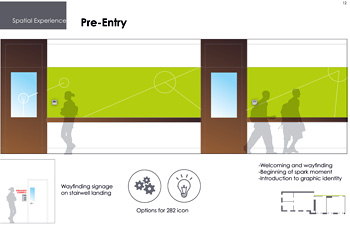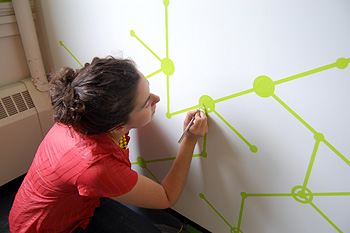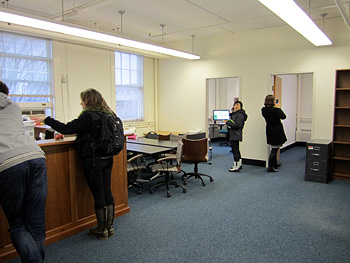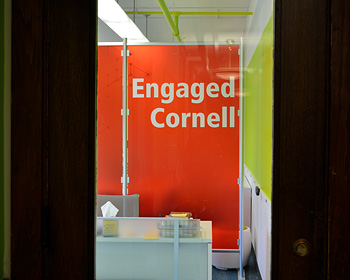
Cerise Marcela '12, M.A. '13 and Brie Reid '12, M.A. '13, two of five student leaders on the redesign project, show off the new space for Cornell's Engaged Learning + Research center in Caldwell Hall. Photo: Mark Vorreuter/College of Human Ecology.
Students devise new design, brand for Engaged Cornell

Rebecca Stoltzfus, M.S. '88, Ph.D. '92, professor in the Division of Nutritional Sciences and provost's fellow for public engagement at the Engaged Learning + Research center, left, with the center's executive director, Richard Kiely, Ph.D. '02, in the center's new and redesigned home on Caldwell Hall's second floor. Photo: Mark Vorreuter/College of Human Ecology.
Leaders of Cornell's Engaged Learning + Research center, founded last fall through a gift from the Einhorn Family Charitable Trust (David Einhorn '91 and Cheryl Strauss Einhorn '91) to revitalize and expand the university's public service mission, faced a problem shortly after moving into their offices on the second floor of Caldwell Hall.
Their new digs stifled engagement: drab and nondescript, with stark white walls, a maze of unsightly pipes along the ceiling and outdated furnishings and carpeting. They wondered how students and faculty members would become passionate about community engagement, service and collaboration in an uninviting space tucked away in a 99-year-old building.
Such worries are gone thanks to a team of Design and Environmental Analysis (DEA) seniors, led by DEA lecturer Leah Scolere '03, M.A. '04; Paula Horrigan, MLA '87, associate professor of landscape architecture; and DEA teaching assistant Katherine Mooney '11, M.A. '12, whose evidence-based design recommendations have remade the center into a kinetic, modern space that invites students, professors and community members to connect for meetings, lectures, workshops and impromptu discussions. As part of the facelift, the design team also offered communications and branding strategies to help the newborn center raise its visibility on campus.
"It's a rare opportunity where a client is starting fresh and is completely open to new ideas on how they operate and how spatial branding and workplace design can help an organization achieve its goals," Scolere says.

In planning documents, student designers imagined a bold design that would extend into the corridor outside the office and attract curious visitors inside.
Once an eyesore, the pipes are coated in electric green paint and, along with a network of nodes hand-painted on the walls in a matching hue, signify the connections the center aims to foster across campus and with the public. There's a small library, a large multipurpose meeting room with adaptable furniture and walls covered in whiteboard paint. Plans call for a recognition wall with photos of faculty members and community engagement projects.
"The new design of the space wakes people up when they walk in the door," says Rebecca Stoltzfus, M.S. '88, Ph.D. '92, professor in the Division of Nutritional Sciences and provost's fellow for public engagement at the center. "Even from the hallway, it invites people in. It starts conversation. It conveys that something new and bold is afoot. And it is comfortable and functional."

This past summer, DEA lecturer Leah Scolere '03, M.A. '04 (pictured) and students hand-painted the nodal network spanning the center's walls.
A catalyst for connections
Then-seniors Cerise Marcela, Gilad Meron, Ada Ng, Carolina Acevedo Pardo and Brie Reid enrolled in Scolere's practice-based design studio and started studying the problem at the beginning of the spring 2012 semester. Early on, they held a visioning session with Stoltzfus; Horrigan; the center's executive director Richard Kiely, Ph.D. '02; Amanda Kittelberger, project manager in the Office of the Senior Vice Provost; staff; undergraduate and graduate students; and Laurie Worrall, executive director of New York Campus Compact, to identify their goals for the space and the organization.
In the visioning session and subsequent interviews, a series of guiding principles emerged: the space in Caldwell should be a catalyst -- one that designers hoped would spark interest in engagement, cultivate connections among campus and community groups, and radiate efforts to the public.

Designers painted the pipes overhead and the nodes on the walls to signify the center's mission to foster connections among students, faculty, staff, and the public.
"There was a need to be bold and break with the expectations of the building, which was traditional and academic," says Scolere. "The common goal was to visualize a new way of thinking about engagement, becoming a hub for engagement efforts that are occurring all over Cornell's campus."
The students' vision also had to bend to some inescapable realities: a small budget, a short timeline and an aesthetic that, according to Horrigan, was a "mish-mash of time periods, remodeling … and spaces that are cut up and disconnected."
As badly as the students wanted to rip up the outmoded carpet and hide the tangle of pipes, such drastic changes would have busted their budget.
"Everyone's first thought was, 'that carpet has to go,'" says Reid, now a Cornell graduate student in the field of interior design. "But you learn to work around those constraints to still be able to push things forward from a design perspective. It's a good lesson for the real world where you will rarely have an unlimited budget."
Scolere praised the students for "leveraging the unique existing characteristics of the space."
Rave reviews
At semester's end, the five students presented their extensive recommendations for remaking the space, including construction drawings, furniture specifications, communications strategies, and a graphics and branding package. Kiely and Stoltzfus approved the plans, and Scolere, Marcela and Kittelberger oversaw renovations during the summer and into the fall semester.

Prior to the makeover, the office spaces on Caldwell Hall's second floor were nondescript.
Initially, they had some unease about how some might respond to the bold transformation. "There was a moment of truth when we were putting bright green paint on the walls," says Marcela, now a graduate student in the field of interior design who is writing her thesis on workplace design.
Kiely says the early response to the center has been "raves from all corners of campus and the community. Everyone says how it is dynamic and conducive to big ideas."
"What's really noteworthy," he adds, "is that this group of senior students, working with an instructor with a professional background as a designer, demonstrates the power of the engaged learning process. From start to finish, their process was attuned to the mission, vision and goals of the center and how to reflect that energy in a contemporary, cutting-edge space."
Four student groups meet there regularly, and roughly a dozen undergraduate and graduate student ambassadors, using the new center as a base, are getting fellow students fired up about engagement.

The new entrance to 260 Caldwell Hall, with a desk for a student greeter to welcome visitors into the space. Photo: Mark Vorreuter/College of Human Ecology.
"It's unlike any space at Cornell," says Marcela. "We hope students will find it and will want to keep coming back."
Ted Boscia is assistant director of communications for the College of Human Ecology.
Links:
Department of Design and Environmental Analysis